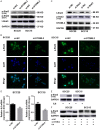STOML2 as a novel prognostic biomarker modulates cell proliferation, motility and chemo-sensitivity via IL6-Stat3 pathway in head and neck squamous cell carcinoma
- PMID: 30899371
- PMCID: PMC6413287
STOML2 as a novel prognostic biomarker modulates cell proliferation, motility and chemo-sensitivity via IL6-Stat3 pathway in head and neck squamous cell carcinoma
Abstract
STOML2 (Stomatin-like protein 2) is up-regulated and acts as an oncogenic protein in multiple cancers. However, the role and regulatory mechanism of STOML2 in head and neck squamous cell carcinoma remain unclear. Here, we found that STOML2 is overexpressed and indicates poor outcomes in HNSCC. In addition, the expression of STOML2 correlates positively with T stage, lymph node metastasis and recurrence. Reduced STOML2 dramatically inhibits cell proliferation, colony formation and motility of HNSCC cells in vitro. Furthermore, the sensitivity of HNSCC cells towards cisplatin is obviously improved in STOML2-silencing cells. Subsequent studies suggest that STOML2 could regulate the expression of IL6 transcriptionally and then further induce the phosphorylation of Tyr705 residue of Stat3, whose activation plays a critical role in HNSCC. Taken together, these results for the first time demonstrate that STOML2 promotes HNSCC progression through activating IL6-Stat3 pathway and provide a promise for diagnosis and treatment for HNSCC.
Keywords: HNSCC; STOML2; Stat3; chemo-sensitivity; invasion; proliferation.
Conflict of interest statement
None.
Figures







References
-
- Jemal A, Bray F, Center MM, Ferlay J, Ward E, Forman D. Global cancer statistics. CA Cancer J Clin. 2011;61:69–90. - PubMed
-
- Leemans CR, Braakhuis BJ, Brakenhoff RH. The molecular biology of head and neck cancer. Nat Rev Cancer. 2011;11:9–22. - PubMed
-
- Posner M, Vermorken JB. Induction therapy in the modern era of combined-modality therapy for locally advanced head and neck cancer. Semin Oncol. 2008;35:221–8. - PubMed
-
- Wang Y, Morrow JS. Identification and characterization of human SLP-2, a novel homologue of stomatin (band 7.2b) present in erythrocytes and other tissues. J Biol Chem. 2000;275:8062–71. - PubMed
-
- Wang Y, Cao W, Yu Z, Liu Z. Downregulation of a mitochondria associated protein SLP-2 inhibits tumor cell motility, proliferation and enhances cell sensitivity to chemotherapeutic reagents. Cancer Biol Ther. 2009;8:1651–8. - PubMed
LinkOut - more resources
Full Text Sources
Molecular Biology Databases
Miscellaneous
